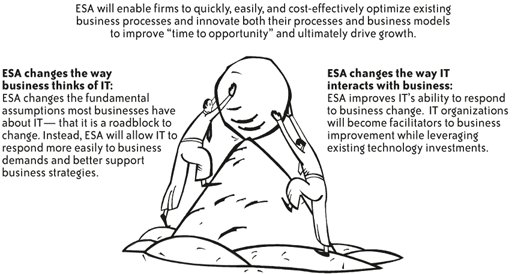Section 3.6. Just how much and what kind of change will ESA involve?
3.6. Just how much and what kind of change will ESA involve?One of the promises of ESA is that you won't have to blow up your IT infrastructure and start over. Once they understand ESA, many IT professionals wonder how wide the scope of change will be. They ask, "Will we have to blow up our infrastructure, org chart, and even supply chain, and start over? How is that a benefit?" No one will have to blow up anyone or anything in the pursuit of ESA, and so far, no one has managed to blow themselves up, either. According to Forrester Research, for example, 75 percent of all large companies (defined as 20,000 employees or more) had begun implementing service-oriented architecture (SOA) components, and their biggest reason by far for doing so was internal integration.[*] The first phase of adoption is largely used to repair and connect the mistakes and unplanned disconnects within the current architecture. Evolving toward ESA is a continuous process marked by steady improvement as the new architecture gradually replaces the old. It does so organically, not via dynamite.
But if you're serious about adopting ESA, you need to think long and hard about where ESA will take your organization before you worry about how, when, and how much it will cost to get there, "there" being a new relationship between business and IT, as shown in Figure 3-1, that supports process innovation and creates lasting competitive advantage. That's the purpose of this chapter. You've read the business case for ESA and found it compelling enough to keep reading. Much of the rest of this book is devoted to the technology and application aspects of implementation and evolutionChapter 7, for instance, contains tactical advice for creating an ESA roadmap. Because ESA isn't IT as usual, realizing its full potentialand, in turn, its potential to transform your businesswill require more than your usual IT department. Likewise, unlocking the functionality buried in siloed enterprise applications has limited value if your corporate organization and culture are unwilling to align themselves in tandem with the new, more efficient, process-oriented focus that ESA makes possible. Figure 3-1. ESA fully aligning IT and business Figure 3-2 shows the dimensions along which a company must manage change. The culture, organization, processes, and systems must move forward in synchronized fashion. The goal is to move from process efficiency to the more advanced levels of process flexibility and process innovation that pave the way to business innovation. To drive this transformation, who within the organization will be asking the questions? How will they know which questions to ask? How will the sudden shift from a legacy of saying no to one of saying yes transform the organization? Will simply handing managers the keys to a gleaming business process machine transform them into the "business analysts" discussed in Chapter 2, or, much more likely, will they need to rethink organizational structures, develop new skills, and have ongoing discussions with external partners, et al., about the ramifications of ESA for their business? You should assume, as this chapter does, that evolving toward ESA requires a pair of parallel processesa technological and a cultural evolutionthat require an equal amount of forethought and preparation. Don't make the mistake of underestimating the cultural challenges and looming revolution when mapping a path to ESA, and don't take anyone's word for what the roadmap should be. Each company's cultural transformation will be highly idiosyncratic. The most an outsider can do is talk about its general shape. Each company must bring the specifics to life on its own. |
EAN: 2147483647
Pages: 265